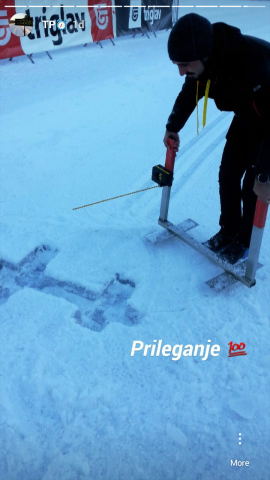With the end of the winter season of cross-country skiing races in Slovenia, I decided to write a bit about my job in sports timing, and the whole ‘behind the scenes’ thingy of what you’ve probably heard of as ‘The Official Timekeeper’. We’re not exactly the equestrian Rolex or the skiing Longines, but we get the job done, well done.

To start with, I have to talk a bit about how I got the job in the first place. Back two years time, after the beginning of my last year of high school, I wasn’t exactly looking for a student job, due to the exams that were coming up. Then one day, my father – quite a cycling enthusiast told me that he found that a timing company was looking for new employees. I thought I had a lot to study and complained about applying at first, but then applied and went to the job interview anyway.

I knew the company – Timing Poljane, as they measured some of the local cycling races, some of which I also attended a few times myself. However, that didn’t stop me from completely not knowing what timing was all about. I had always thought of the timing as just a bunch of guys with stopwatches, but man did they prove me wrong. At the interview – which was more like a get-to-know meet, I was presented with a whole lot of timing equipment, and races which the company measured across the season.

From spring to fall, the races are largely running races, for a cup Gorenjska: Moj Planet (held by Timing Poljane) and some smaller cycling races. Through the winter, there are cross-country skiing races for Geoplin cup, usually happening at Pokljuka and Planica sports centers, and some smaller cross-country skiing centers. You might think that for timing, those are quite similar events, which require the same timing equipment, but you couldn’t be farther from the truth.

Running events usually feature group starts of different categories, which means a lot of athletes in a short amount of time, in short – a timekeeper’s nightmare. With that in mind, sport timing services try to use equipment that helps their employees and minimizes the chance for human error. A common example is a Jaguar system that uses antennas and magnetic chips, is connected to the computer and is largely automatic, except for the start button. Another option is a special program, coded and owned by the company which requires manually pressing stop for each athlete and works great if athletes don’t come in great numbers.

For winter events, procedure changes quite a bit. In cross-country skiing, athletes within a category usually start individually. There are a few different disciplines: individual (classic, skate, and ski-cross) or relay. For that, we use an Alge Timing system, which uses a digital clock, and a photocell for the finish line. It can be combined with a display clock to show race time for each athlete that crosses the finish line.

There are endless options and arrangements for measurement, but just as important is the result-publishment. All the race data is contained in an .xml or similar form on a clock or even computer. This data has to be divided into the right categories and exported as .xls so it can be printed and posted as an Excel document. Some programs have that function integrated, and for others, we have yet another program that does just that.

I quickly found that a simple race can get quite complex if you’re not one-hundred percent sure what you are doing. So, what if anything goes wrong, you might ask. Usually, the errors happen due to bad communication or faults in the event organization. For example, a number mismatch or someone starting a bit late can lead to an error in results. We tend to sort any errors out by the end of the race. However, a possible big error has to be taken care of after, as there is just not enough time mid-race.
Timing is a job with a lot of responsibility and is also quite fun if everything goes well at the race. So far, we’ve even managed some races with FIS rules, and are eager to further expand the range of races we measure throughout the year. If you liked the article, be sure to check out the Timing Poljane’s website http://www.timingpoljane.si/.
Disclaimer: All photographs used in this post are from my Instagram story feed, except for the cover photo, which is from Timing Poljane’s Facebook page.
